There was a point in time in the history of workstation computing, when the list of core silicon processor vendors was a long one. Back in the 90’s, the names were many, including the workstation vendors themselves who engineered their own CPUs and GPUs. But that’s not the case any longer, as for all intents and purposes, the list is down to just three: Intel, Nvidia and AMD. Virtually every CPU and GPU shipping in a CAD workstation today comes from one of these vendors. While supporting subsystems, like memory and storage, have to provide commensurate capabilities, how fast your machine cranks through your design, simulation, and visualization tasks depends on the horsepower those CPUs and GPUs can muster.
None of the three stand still for too long, periodically upgrading their processor wares to entice professional users to replace their current systems — or perhaps upgrade a graphics card – with the promise of a worthwhile gain in productivity. Sometimes those technology upgrades come from relatively minor tweaks, and other times from a ground-up architectural overhaul. In some cases, vendor’s releases are staggered, and other instances timed to allow an OEM to refresh both key components at the same time.
This year, the industry has witnessed one of the broadest and deepest refreshes ever, from all three vendors across all workstation-focused product lines, and all delivered in close succession. Those introductions have been rippling through OEMs workstation models in the last few months, now offering CAD users one of the more compelling opportunities to dial up their workflow throughput in years.
The Xeon W-2400: Intel’s Long — Emphasize Long — Awaited Successor to the Xeon W Line
First up is Intel, which despite AMD’s obvious advances in technology, performance, and market share in PC and server markets, remains the dominant CPU supplier for workstations serving CAD markets. While AMD has successfully nibbled on Intel’s share in workstations with its Threadripper Pro and Ryzen Pro lines — both of which have earned Tier 1 OEM support — Intel retains overwhelming share today. Notably, it’s managed to do so despite uncharacteristic stumbles in execution and lagging refresh cycles.
This year, Intel has finally bolstered not one but its entire trio of workstation-focused CPU lines: Core at the entry level, Xeon W at the mid-range and above, and Xeon Scalable at the dual-socket top end. Now, of those three, Core was the company’s lesser issue. Yes, Core lost some competitiveness earlier this decade, due in part to Intel’s acknowledged struggles with advanced manufacturing processes. But Intel was quicker to right that ship, and its 12th and 13th Generation Core (Alder Lake and Raptor Lake, the former’s impressive technological advances covered here) have stemmed the tide and re-established Core as the CPU-to-beat at the entry level. At the top-end, the dual-socket capable Xeon Scalable had stagnated, but with the dual-socket workstation segment shrinking, now representing an increasingly small market niche, any loss in Xeon Scalable competitive edge would barely show up in Intel’s workstation CPU volume.
Rather, Intel’s glaring competitive hole in its workstation CPU portfolio has been Xeon W, the line serving the premium mid-range fixed segment of the market. Entering 2023, the Xeon W-2200 product generation was still anchoring Tier 1 (Dell/HP/Lenovo) OEMs’ premium workstation models, nearly four years after launch. (There had been one intermediate refresh, but for several reasons was not picked up at the Tier 1 level). Fortunately, the emergence of the Sapphire Rapids generation of Xeon (covered in depth here) has remedied that situation in a big way.
Garnering more of the Sapphire Rapids launch limelight earlier this year was the Xeon W-3400 line, offering core counts up to 56 to offer a much-needed, credible competitor to AMD’s up-to-64C Threadripper Pro 5900WX line that has been gaining ground at the top end of the single-socket (1S) workstation market. But limelight doesn’t necessarily correlate with market impact, as more often it’s the lesser-touted but mainstream priced products that yield the bulk of the eventual revenue stream. Such is the case with Sapphire Rapids.
Yes, the Xeon W-3400’s jump in available core counts was a critical step to answer AMD’s Threadripper Pro in the very top end of the workstation market, but it’s the W-2400 that anchors the valuable mid-range, sandwiched between the Core offerings below and the more expensive W-3400 above. More importantly, it’s put an end to the long 4-year pause in technology updates for that key segment. How convincing an end? Benchmarking with SPECworkstation indicates a dramatic upgrade in performance a CAD user can expect moving from the previous generation W-2200 up to the W-2400. Comparing the top-end Xeon W-2495X with the previous flagship W-2265, we find an average 115% improvement in throughput for a wide selection of SPECworkstation tests (version 3.0.4. for historical consistency).
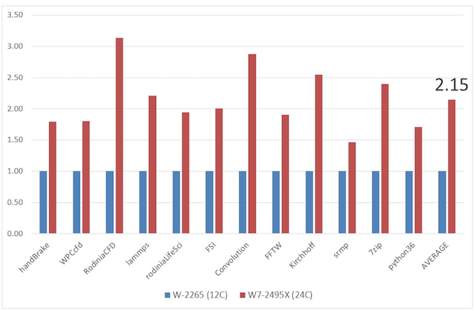
The new 24C Xeon W7-2495X outperforms the incumbent 12C W-2265 by 115% on SPECworkstation’s common professional computing workloads. Click image to enlarge.
Of course, the W7-2495X offers twice the number of cores as the W-2265, so one might argue this isn’t a fair fight. I’d counter that it absolutely is, because the ultimate apple in an apples-to-apples match-up is price. With an introduction at a similar point in that spectrum, it’s the most relevant comparison to buyers, and a doubling of core count at the same price is a logical improvement expected from more than one step in process shrinks.
Furthermore, doubling performance just because you’ve doubled cores is anything but a given conclusion. First off, while SPECworkstation does sensibly leverage multi-threaded (MT) workloads, the degree of multi-threading is neither constant over time nor consistent in breadth. Second, even an ideal multi-threaded sequence will still need to have its throughput supported system-wide by software (application and OS) and hardware (microarchitecture, memory and storage). Given those limitations, a greater than 2X improvement is both a commendable achievement and — if you’re Intel — a very welcome one.
With the RTX 5000 Ada Generation, Nvidia Takes Another Step in its Transition from Ampere to Ada
Intel’s dominance in processor volume is eclipsed by one other vendor: Nvidia in professional GPU shipments. Unlike Intel, it hasn’t stumbled recently, but rather continues an enviable run of generation-to-generation technology and product execution. It’s currently transitioning from previous generation Ampere to 2023’s Ada. Ada has already spawned two products for fixed/deskside workstations—led by the top-end and very pricy RTX 6000 Ada Generation — as well as a slew of GPU modules for mobile workstations, all announced in unison as the first round of Ada-derived professional RTX GPUs in Q2 of 2023.
The transition has recently taken its next logical step down the RTX product line. The RTX 5000 Ada Generation sits one notch below the 6000 on Nvidia’s price spectrum, but at a street price that will likely sit around $2,900 or so, it still classifies as an ultra-high-end product. The RTX 5000 Ada Generation succeeds the duo of the RTX A5000 and subsequently released resource-boosted A5500, both derived from Ada’s predecessor, Ampere. Not surprisingly, the RTX 5000 Ada Generation offers resources trimmed down from the 6000 for Ada’s three primary classes of compute engines integrated in the architecture’s shader multiprocessors (SMs): CUDA cores, RT cores (accelerating ray-tracing algorithms for rendering), and Tensor cores (to primarily accelerate machine learning though that support also contributes to faster rendering). Generation to generation, however, all three computing resources climb from Ampere’s 5000 class to Ada’s.
Salient hardware metrics for RTX 5000 Ada Generation GPU and its predecessor, the RTX A6000. Data Source: Nvidia. Click table to enlarge.
AMD Launches Next Professional GPU Salvo in Battle to Take Meaningful Market Share from Nvidia
Nvidia may be dominating professional GPU sales, but it’s not because rival AMD is taking any kind of break. The latter continues to churn through its own timely, generation to generation improvements, now moving from its RDNA2 GPU architecture to RDNA3. First out for AMD are a pair of ultra-high end cards (defined in my workstation tracking with Jon Peddie Research as prices above $1,500), the Radeon Pro W7900 and W7800. Intentionally moving upstream to capture higher-margin sales at the top end of the market, the W7900’s (approximate) $4,000 ASP will match it up roughly with Nvidia’s RTX 6000 (though the latter still priced significantly higher). At around $2,900, the W7800 will line up squarely against Nvidia’s new RTX 5000.
AMD’s new Radeon Pro W7900 and W7800 bring RDNA 3 technology to the high-volume mid-range. Data source: AMD. Click table to enlarge.
Worth noting about the W7900 is that is the first triple-slot card I’ve seen to date (or at least remember ever seeing). In this case, triple-slot and dual-slot implies that the card physically occupies three or two add-in card slot width, not that they use multiple electrical connectors. While dual-slot cards are common at the high end of the market — to accommodate thermal dissipation — the triple-slot W7900 is unique and requires explicit allowances in the OEM’s chassis design.
 Nvidia Ada and AMD RDNA3: Both Generations Deliver Drive Up Visual Computing Performance for 3D Graphics and 3D Rendering
Nvidia Ada and AMD RDNA3: Both Generations Deliver Drive Up Visual Computing Performance for 3D Graphics and 3D Rendering
When it comes to more traditional, interactive 3D graphics, SPECviewperf (in the latest 2020 version) remains the go-to benchmark for CAD and other applications with heavy professional-geared visual processing. Testing Nvidia’s RTX 5000 and RTX 6000, along with AMD’s Radeon Pro W7900 and W7800 with SPECviewperf 2020 on the same workstation yielded the following results. Comparisons to each vendor’s market predecessor (similar price) as well as the rival’s closest competitor are shown.
The RTX 5000 Ada Generation GPU ran through the SPECviewperf 2020 viewsets on average 56% faster than the RTX A5000 (with the A6000 Ada Generation, tossed in for context, about 73% higher). Subjectively, I tend to judge a 50% gain as an admirable and compelling gain for a generation-to-generation improvement in 3D graphics throughput, and the RTX 5000 Ada Generation checks that box with some headroom. (Bear in mind, the A5000 kicker, the A5500, was not tested here and likely would deliver results somewhere between the two.)
SPECviewperf 2020 results for the RTX 5000 (and 6000) Ada Generation, normalized to the Ampere Generation RTX A5000. Source: Jon Peddie Research. Click to enlarge.
AMD’s Radeon Pro W7800 and W7900 both took big steps forward in performance, yielding average SPECviewperf 2020 gains of 58% and 89%, respectively, compared to the most comparable predecessor, 2021’s W6800. Bear in mind, though, that while ASPs vary over product cycles, the W6800 (around $2,200 at mid-product cycle) was significantly less expensive than W7900 and, when all is said and done, the W7800 will likely sell for somewhat more as well.
SPECviewperf 2020 results for the RDNA3 generation Radeon Pro W7900 and W7800, normalized to the previous-gen RDNA2 Radeon Pro W6800. Source: Jon Peddie Research. Click to enlarge.
Lastly, let’s take a look at how the latest from Nvidia and AMD stack up against each other. The caveat here is that market pricing — the most important criterion to set up a fair comparison — is not equivalent, but more on that just ahead. First up, Nvidia’s RTX 5000 relative to AMD’s Radeon Pro W7800, with performance of each normalized to that price tier’s incumbent: Nvidia’s previous generation RTX A5000.
SPECviewperf 2020 results for the RDNA3 generation Radeon Pro W7800 and Nvidia RTX 5000 Ada Generation normalized to the previous-gen AMD Radeon Pro W6800 and Nvidia RTX A6000. Source: Jon Peddie Research. Click to enlarge.
Moving a notch up on both vendors’ product lines, we see both the Radeon Pro W7900 and RTX 6000 deliver solid performance gains over the incumbent RTX A6000, 35% and 42% on average (respectively), with the Nvidia card delivering the top score.
SPECviewperf 2020 results for the RDNA3 generation Radeon Pro W7900 and Nvidia RTX 6000 Ada Generation normalized to the previous-gen Nvidia RTX A6000 Source: Jon Peddie Research. Click to enlarge.
But Remember, Purchase Criteria Factors in Price as Well … Except When it Doesn’t
So that’s it then, with the results above we conclude that Nvidia’s RTX Ada generation is better than AMD’s RDNA3-class Radeon Pro? No, and for a couple of reasons. First off, while SPECviewperf remains the best test suite for professional graphics, no benchmark is perfectly applicable to all users and workflows. And furthermore, results tend to be a bit less relevant in the context of the upper end of the market where, for example, the money spent on big GPU memory footprints is unlikely to pay off on a benchmark score but may be critical for a specific workflow. Second, and more importantly, comparing performance in the absence of pricing isn’t relevant for the vast majority of buyers that select on a budget, even a big budget like one that could entertain a $2,500 RTX 5000.
Sure enough, comparing price-performance yields a different perspective in the context of the RTX 5000 and Radeon Pro W7800. Adjusting the measure, the Radeon Pro W7800 and RTX 5000 score nearly the same in performance-per-dollar, with sensible improvements over the previous generation W6800. Interestingly, at a similar level is the previous generation RTX A5000, not because the newer generations don’t deliver meaningful gains, but because the market price for the A5000 has naturally declined since its introduction and particularly as the new Ada generation rolled out. The chart below underlines that assertion in this and most any marketplace: that price tends to even out the playing field. If it didn’t, wouldn’t most anyone who bought an RTX 5000 Ada just as soon have chosen an RTX 6000 Ada?
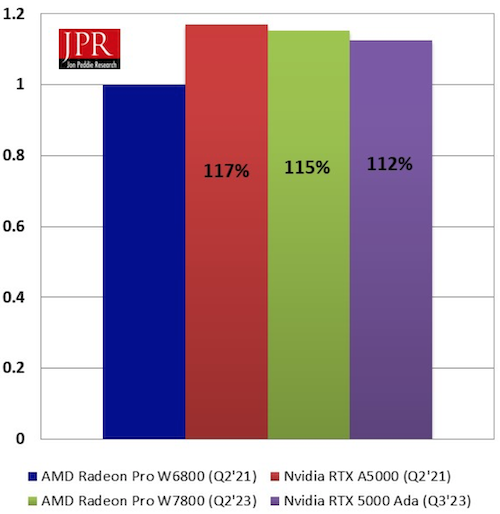
SPECviewperf 2020 scores-per-ASP for the RDNA3 generation Radeon Pro W7800 and Nvidia RTX 5000 Ada Generation normalized to the previous-gen Radeon Pro W6800 Source: Jon Peddie Research.
That assertion makes a perfect segue in a shift over to look at the price-performance of the RTX 6000 Ada Generation and Radeon Pro W7900, as well as the previous-generation RTX A6000. Because with this group, we don’t see that same clustering of very similar, market-driven scores-per-dollar, rather we see the W7900 way ahead. Why? Because this is the very top-end of the market, representing that one exception to the price-always-matters rule, where for many buyers, cost is essentially a non-issue. They have to have the highest performance available, period, and if that’s all that matters, the RTX 6000 Ada Generation stands out. In fact, this snapshot chart (based on prices sampled online as of this writing) indicate that the RTX 6000 Ada Generation price not only hadn’t experienced any decline from its introduced SRP of $6,800, it was actually running at a premium, closer to $8,000.

SPECviewperf 2020 scores-per-ASP for the RDNA3 generation Radeon Pro W7900 and Nvidia RTX 6000 Ada Generation normalized to the previous-gen RTX A6000 (estimated price based on a sampling of popular online retailers as of this writing).
GPU Rendering No Longer an Afterthought but Rather a Key Criterion
Moreover, cards of the class of the RTX 6000 and 5000 Ada Generation are less likely to be judged on 3D graphics performance alone (or even at all), as rendering, GPU computation, and machine learning would likely be the bigger draws. On the RTX side, Ada Generation GPUs are delivering even more dramatic throughput gains in rendering than for 3D graphics. Compared to an RTX A5000, the RTX 5000 Ada Generation manages around 68% faster rendering (on Blender Cycles benchmark) while the RTX 6000 Ada Generation doubles that gain to around 140%. Given the magnitude of these gains, consider an application in which achieving or even approaching real-time rendering of complex scenes is a non-negotiable objective, and it’s easier to imagine that in such cases — albeit rare ones — price truly might not matter.
Blender Cycles rendering benchmark results for the RTX 5000 (and 6000) Ada, relative to the previous-generation RTX A5000.
The Impact in the Markets for Workstation-Caliber CPUs and GPUs
If you’re asking yourself if we should be spending this much time assessing the capabilities of GPUs whose prices relegate them to niche CAD usage, you’d be justified. No question, cards like the Radeon Pro W7900 and W7800 or RTX 6000 and 5000 Ada Generation are not going to make it into many Cadalyst readers’ CAD machines. But these measures and perspectives are still quite relevant, because they directly foreshadow the aptitude of the GPUs that will most certainly be filling their machines with in the coming year or two.
Ada is propagating step by step down Nvidia’s workstation-class RTX GPU line, now occupying the familiar 6000, 5000, and 4000 model-number positions in the portfolio. While a bit more affordable than the 6000 Ada Generation — in the $7,000+ range, serving a tiny corner of the market — the 5000 Ada carries a $2,900 (estimated street) price tag that will make it far from pervasive as well. But, consider what’s likely coming in short order. Subsequent steps down the price curve are all but inevitable for both vendors, and we can expect mid-range and entry-level GPUs from both the Ada and RDNA3 generations will yield similar generation-to-generation speedups as the initial high-end SKUs launched first and reviewed here. Nvidia already has one that at least flirts with mid-range price points, the RTX 4000 in an SFF form factor that will likely drift down in price towards $1K over time, while conventional full-length high-profile RTX 4000 and RTX 4500 cards have just been announced and expected to ship shortly.
AMD’s Radeon Pro is at a similar point, mid-stream in its product line transition to RDNA3. The W7900 and W7800 anchoring the top end of the line is just the first salvo in the company’s latest attempt to take some share from dominant Nvidia. Already announced (with product available presumably in the coming weeks) are the mid-range W7600 and W7500, cost-reduced RDNA3 siblings expected to sell for around $599 and $429, respectively. That puts both square in the highest-volume mid-range sweet spot, making RDNA3 technology available to the full breadth of the CAD market.
What might we expect of AMD’s market prospects moving forward on the back of RNDA3 and slew of new models? The company clearly faces a challenge, as Nvidia has proven to be a very formidable — if not the most formidable — competitor among all semiconductor suppliers. But while Nvidia and RTX currently dominate professional GPU shipments, remember that if there’s a vendor that’s used to being the position of number two, battling it out against a well-equipped and deep-pocketed incumbent, it’s AMD. It wasn’t long ago that AMD was viewed as an afterthought in CPUs — taking minority share and consistently coming up short to Intel — yet look how far it’s come in that market the last few years.
Accordingly, it would be shortsighted for Nvidia to assume its position as dominant supplier is assured. AMD is building solid products with price-performance to match — at least with respect to 3D graphics. Credit Nvidia’s execution, because the only reason AMD hasn’t been rewarded with appreciable market share gains is because Nvidia hasn’t provided many opportunities to do so. One misstep like Intel’s, though, and AMD is positioned to capitalize.
It was precisely Intel’s stumble in execution — more critically on the manufacturing side —that left the incumbent in the uncomfortable position of being not the predator but the prey, with an urgent need to restore its competitive edge. With the generations of its Core line (12th Gen Alder Lake and 13th Gen Raptor Lake) in 2022 and 2023, it’s done so in the entry-level mainstream of CAD computing markets. And now – albeit belatedly — it’s successfully established Sapphire Rapids generation Xeon, incarnated both as successor in the W-2000 class as well as newfound competitor in the SSS class with the W-3400, competing head-on with AMD’s Threadripper Pro in the upper-end of the market. The previous Sapphire Rapids coverage here would indicate the W-3400 won’t likely shut down Threadripper Pro incursion, but it should stem the tide and let Xeon better defend that high-end turf. In the end, though, it’s this W-2400 line that should do the most to reinforce Intel’s position in workstation computing, returning leadership performance in that valuable workstation mid-range.
Alex Herrera
With more than 30 years of engineering, marketing, and management experience in the semiconductor industry, Alex Herrera is a consultant focusing on high-performance graphics and workstations. Author of frequent articles covering both the business and technology of graphics, he is also responsible for the Workstation Report series, published by Jon Peddie Research.
View All Articles

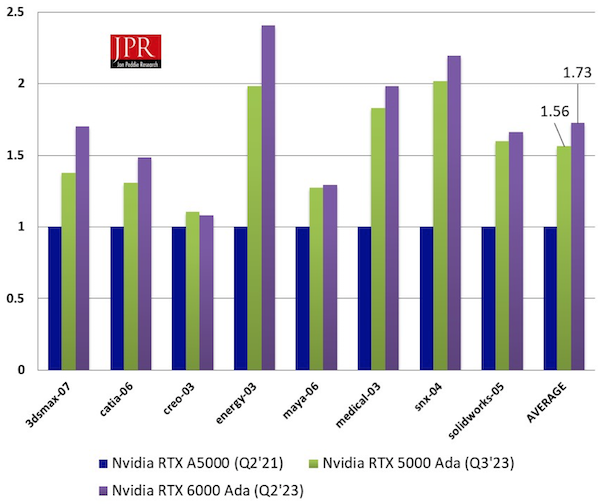
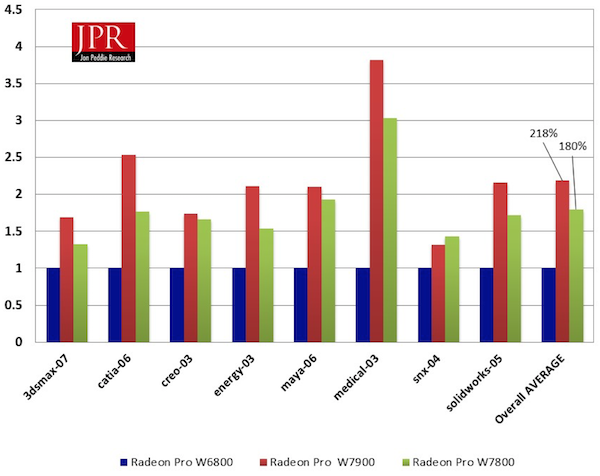


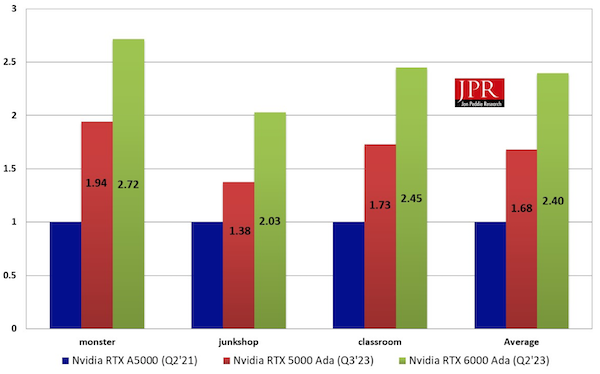





Share This Post